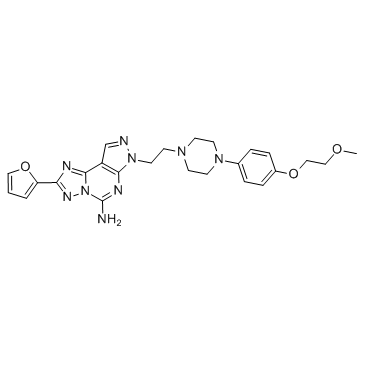
Preladenant
CAS No. 377727-87-2
Preladenant( SCH-420814 | SCH 420814 | SCH420814 )
Catalog No. M14304 CAS No. 377727-87-2
A potent and highly selective A2A receptor competitive antagonist with Ki of 1.1 nM.
Purity : >98% (HPLC)
 COA
COA
 Datasheet
Datasheet
 HNMR
HNMR
 HPLC
HPLC
 MSDS
MSDS
 Handing Instructions
Handing Instructions
| Size | Price / USD | Stock | Quantity |
| 2MG | 43 | In Stock |


|
| 5MG | 69 | In Stock |


|
| 10MG | 113 | In Stock |


|
| 25MG | 201 | In Stock |


|
| 50MG | 332 | In Stock |


|
| 100MG | 494 | In Stock |


|
| 500MG | 1071 | In Stock |


|
| 1G | Get Quote | In Stock |


|
Biological Information
-
Product NamePreladenant
-
NoteResearch use only, not for human use.
-
Brief DescriptionA potent and highly selective A2A receptor competitive antagonist with Ki of 1.1 nM.
-
DescriptionA potent and highly selective A2A receptor competitive antagonist with Ki of 1.1 nM; has >1000-fold selectivity over all other adenosine receptors; attenuates hypolocomotion induced by the A2AR agonist CGS-21680; potentiates L-Dopa -induced contralateral rotations after 6-hydroxydopamine lesions in the medial forebrain bundle in rats (0.1-1 mg/kg); orally active.(In Vitro):Preladenant also completely antagonizes cAMP in cells expressing the recombinant human A2A receptor. Preladenant is determined to has KB values of 1.3 nM at the A2A receptor; the value is in good agreement with the Ki value determined in the radioligand binding assay. A similar functional assay with A2B receptor-expressing cells is used to demonstrate selectivity over A2B receptors. In this assay, the KB value for Preladenant is 1.2 μM, indicating that Preladenant is 923-fold selective for the A2A receptor over the A2B receptor. (In Vivo):Preladenant (1 mg/kg) inhibits L-Dopa-induced behavioral sensitization after repeated daily administration, which suggests a reduced risk of the development of dyskinesias. Preladenant exhibits antidepressant-like profiles in models of behavioral despair, namely the mouse tail suspension test and the mouse and rat forced swim test. Preladenant produces a dose-dependent reduction in parkinsonian scores at doses of 1 mg/kg (min score: 9.0) and 3 mg/kg (min score: 6.5). A subthreshold dose of Preladenant reduces minimum and mean parkinsonian scores in animals treated with 3 mg kg of L-Dopa to 5.25 and 6.88 respectively. A Wilcoxin test is used to compare individual treatments against vehicle. Preladenant (3 mg/kg), L-Dopa (3, 6, and 12 mg/kg), and the combination of Preladenant and L-Dopa (1 or 3 mg/kg+3 mg/kg) are all significantly improved on the minimum parkinsonian score. In addition, both the 12 mg/kg L-Dopa and L-Dopa+Preladenant groups are significantly improved on both minimum and mean parkinsonian scores relative to the 3 mg/kg L-Dopa group.
-
In VitroPreladenant also completely antagonizes cAMP in cells expressing the recombinant human A2A receptor. Preladenant is determined to has KB values of 1.3 nM at the A2A receptor; the value is in good agreement with the Ki value determined in the radioligand binding assay. A similar functional assay with A2B receptor-expressing cells is used to demonstrate selectivity over A2B receptors. In this assay, the KB value for Preladenant is 1.2 μM, indicating that Preladenant is 923-fold selective for the A2A receptor over the A2B receptor.
-
In VivoPreladenant (1 mg/kg) inhibits L-Dopa-induced behavioral sensitization after repeated daily administration, which suggests a reduced risk of the development of dyskinesias. Preladenant exhibits antidepressant-like profiles in models of behavioral despair, namely the mouse tail suspension test and the mouse and rat forced swim test. Preladenant produces a dose-dependent reduction in parkinsonian scores at doses of 1 mg/kg (min score: 9.0) and 3 mg/kg (min score: 6.5). A subthreshold dose of Preladenant reduces minimum and mean parkinsonian scores in animals treated with 3 mg kg of L-Dopa to 5.25 and 6.88 respectively. A Wilcoxin test is used to compare individual treatments against vehicle. Preladenant (3 mg/kg), L-Dopa (3, 6, and 12 mg/kg), and the combination of Preladenant and L-Dopa (1 or 3 mg/kg+3 mg/kg) are all significantly improved on the minimum parkinsonian score. In addition, both the 12 mg/kg L-Dopa and L-Dopa+Preladenant groups are significantly improved on both minimum and mean parkinsonian scores relative to the 3 mg/kg L-Dopa group.
-
SynonymsSCH-420814 | SCH 420814 | SCH420814
-
PathwayApoptosis
-
TargetAdenosine Receptor
-
RecptorA2A
-
Research AreaNeurological Disease
-
Indication——
Chemical Information
-
CAS Number377727-87-2
-
Formula Weight503.5563
-
Molecular FormulaC25H29N9O3
-
Purity>98% (HPLC)
-
SolubilityDMSO
-
SMILESNC1=NC(N(CCN2CCN(C3=CC=C(OCCOC)C=C3)CC2)N=C4)=C4C5=NC(C6=CC=CO6)=NN15
-
Chemical Name7H-Pyrazolo[4,3-e][1,2,4]triazolo[1,5-c]pyrimidin-5-amine, 2-(2-furanyl)-7-[2-[4-[4-(2-methoxyethoxy)phenyl]-1-piperazinyl]ethyl]-
Shipping & Storage Information
-
Storage(-20℃)
-
ShippingWith Ice Pack
-
Stability≥ 2 years
Reference
1. Neustadt BR, et al. Bioorg Med Chem Lett. 2009 Feb 1;19(3):967-71.
2. Hodgson RA, et al. J Pharmacol Exp Ther. 2009 Jul;330(1):294-303.
3. Hodgson RA, et al. Exp Neurol. 2010 Oct;225(2):384-90.
molnova catalog



related products
-
Regadenoson
Regadenoson is an adenosine derivative and selective A2A adenosine receptor agonist with coronary vasodilating activity.
-
Guanabenz hydrochlor...
Guanabenz hydrochloride is an orally active α2-adrenoceptor agonist with hypotensive effects.
-
Penbutolol sulfate
Penbutolol sulfate is able to bind to both β2-adrenergic receptor and β1-adrenergic receptor, thus making it a non-selective β blocker.



 Cart
Cart
 sales@molnova.com
sales@molnova.com


